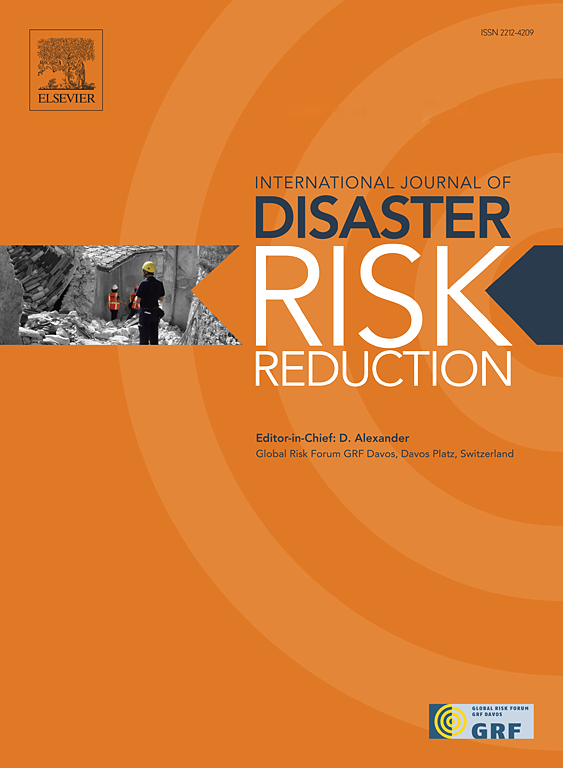2019年11月11日地震至今勒泰伊灾后重建的后续研究:对建筑重建的洞察与放大
IF 4.5
1区 地球科学
Q1 GEOSCIENCES, MULTIDISCIPLINARY
International journal of disaster risk reduction
Pub Date : 2025-04-02
DOI:10.1016/j.ijdrr.2025.105438
引用次数: 0
摘要
2019年11月11日,法国罗纳河谷勒泰伊市发生里氏4.9级地震。大约2800座暴露的建筑中有四分之一遭到破坏,导致安全疏散命令。法国地质调查局(BRGM)受法国生态过渡和领土凝聚部委托,收集有关重建进展的定量数据。这项工作的重点是现场监测某些弹性参数,如重建和修复的时间。根据法国地震工程协会(AFPS)所做的地震后紧急建筑安全检查,对勒泰伊市建筑物的重建进行了不同规模的研究:建筑物、公共间和公共间。解释损伤观察和建模重建需要多种信息来源,因此拥有这三种不同尺度的数据很重要。根据损坏建筑物数据库中的参考状态,为了评估重建进度,根据每年从街道层面进行的目视检查,为建筑物分配了一个重建阶段。此外,还采用了一套指标来提供随时间变化的定量信息,例如(发布和取消的)疏散令的数量或已开始重建进程的建筑物的数量。此外,本研究还包括建筑物的详细分类、脆弱性估计和基于结构加固水平假设的预测风险情景计算。这些因素提出了关于重建的重要问题,特别是从设计标准的角度来看。最后,我们强调物理脆弱性和恢复能力的重要性,这是重建进程的两个主要组成部分。这项工作在收集法国地震后重建的记录和观察方面是开创性的努力,历时多年。本文章由计算机程序翻译,如有差异,请以英文原文为准。
Follow-up of the Post-seismic reconstruction in Le Teil from the November 11th 2019 seismic event to now: Insights and zoom over building rehabilitation
The magnitude Mw 4.9 earthquake of November 11, 2019 strongly affected the municipality of Le Teil, Rhone Valley, France. A quarter of around 2,800 exposed buildings were damaged, which led to safety evacuation orders. BRGM, the French Geological Survey, was commissioned by the French Ministry of Ecological Transition and Territorial Cohesion to collect quantitative data about the progress of the reconstruction. This work focuses on field monitoring of certain resilience parameters, such as the time for reconstruction and repairs. On the basis of emergency post-earthquake building safety inspections done by the French Association for Earthquake Engineering (AFPS), the reconstruction of buildings in the municipality of Le Teil is studied at different scales: building, infra-communal and communal. Interpreting damage observations and modelling reconstruction requires multiple sources of information, hence the importance of having data at these three different scales. Based on their reference state in the damaged buildings database, and in order to assess the progress of the reconstruction, the buildings are assigned a reconstruction stage based on annual visual inspections conducted from street level. In addition, a set of indicators has been employed to provide quantitative information evolving over time, such as the number of evacuation orders (issued and lifted) or the number of buildings whose reconstruction process has begun. Moreover, this study includes a detailed classification of the buildings, estimations for their vulnerability and predictive risk scenario calculations depending on assumptions about the level of structural reinforcement. These elements raise important questions about the reconstruction, particularly from the point of view of design standards. Finally, we highlight the importance of physical vulnerability and recovery capacities, two main components of the reconstruction process. This work constitutes a pioneering effort in terms of collecting records and observations of post-earthquake reconstruction in France, over a multi-year timespan.
求助全文
通过发布文献求助,成功后即可免费获取论文全文。
去求助
来源期刊

International journal of disaster risk reduction
GEOSCIENCES, MULTIDISCIPLINARYMETEOROLOGY-METEOROLOGY & ATMOSPHERIC SCIENCES
CiteScore
8.70
自引率
18.00%
发文量
688
审稿时长
79 days
期刊介绍:
The International Journal of Disaster Risk Reduction (IJDRR) is the journal for researchers, policymakers and practitioners across diverse disciplines: earth sciences and their implications; environmental sciences; engineering; urban studies; geography; and the social sciences. IJDRR publishes fundamental and applied research, critical reviews, policy papers and case studies with a particular focus on multi-disciplinary research that aims to reduce the impact of natural, technological, social and intentional disasters. IJDRR stimulates exchange of ideas and knowledge transfer on disaster research, mitigation, adaptation, prevention and risk reduction at all geographical scales: local, national and international.
Key topics:-
-multifaceted disaster and cascading disasters
-the development of disaster risk reduction strategies and techniques
-discussion and development of effective warning and educational systems for risk management at all levels
-disasters associated with climate change
-vulnerability analysis and vulnerability trends
-emerging risks
-resilience against disasters.
The journal particularly encourages papers that approach risk from a multi-disciplinary perspective.
 求助内容:
求助内容: 应助结果提醒方式:
应助结果提醒方式:


